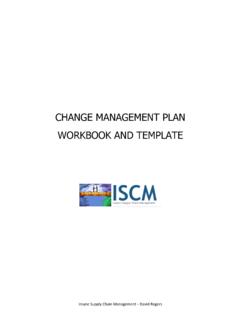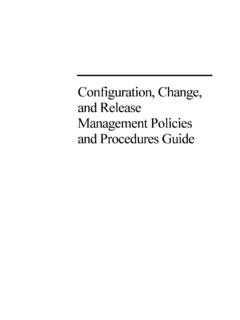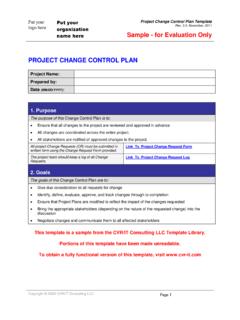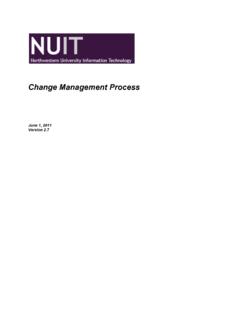Transcription of Department of Commerce Guidelines Change …
1 Department of Commerce Guidelines Change management Guideline Issue No: First Published: Sept 1997 Current Version: May 2002 Table of Contents 1. 2. OBJECTIVES AND SCOPE OF 3. 4. KEY 5. Identify Key Change management Build and Maintain Effective Project Build Commitment Through Effective Acknowledge and Manage 10 Build Synergy Through 6. Change management Guideline Page 1 of 13 1. Introduction The purpose of this Guideline is to promote an understanding of the key requirements for the successful management of the Change within an agency, such as changes in work practices and business processes that are associated with information and communications technology (ICT) projects. ICT projects may involve applications, infrastructure, supporting technologies, information management , and telecommunications projects, including the acquisition and/or maintenance of telephone, radio and network infrastructure.
2 Change management involves understanding the level of Change that a project will cause to an agency and its people, and proactively developing strategies and action plans to manage the impact of that Change . Change management does not relate to the management of internal changes to a project such as program Change control. Change management is often one of the most significant components of a project and can be a larger and more complex task than the project's development and implementation phases. While the concepts and issues covered by this Guideline are primarily intended to promote improved management of the Change associated with ICT projects, they can equally be applied to other projects and activities undertaken by an agency. Change management is one of three core elements of a project.
3 The other two elements are Project Risk management and Quality management and these are the subject of separate Guidelines . Failure to effectively implement each of these three elements could jeopardise the project. 2. Objectives and Scope of Guideline Most projects that an agency undertakes, regardless of whether the project includes a technology component, will result in changes to the agency and the way in which its people work. A successful project devotes significant attention to managing the impact of these changes. The agency's Chief Executive Officer (CEO) and senior management must demonstrate commitment to the Change , and the larger the Change , the greater the need for a senior Project Sponsor. However, the importance of their role in the management of Change is not always clear.
4 This Guideline provides advice on best practice in Change management , but does not attempt to define a Change management methodology. It describes: The role of senior management in Change ; What senior management should expect to occur to manage the Change associated with a project; The questions to ask to determine whether Change management is occurring effectively. Change management Guideline Page 2 of 13 Change management is a core element of the successful management of a project and must be an area of focus throughout the life of the project. The scope of this Guideline is best practice in Change management from the development of the concept for the project through to the realisation of the project's benefits. 3. Concepts Resistance to Change , which can include valid questioning of the need for the Change , is a natural part of almost all projects.
5 Without managing the Change to the agency and its people's work patterns the potential benefits of a project are unlikely to be fully realised. The identification of sources of potential resistance and the development of a plan to manage that resistance is essential if the project's risks are to be reduced and the likelihood of successful implementation increased. New technology is just one dimension of the Change associated with a project. Organisations will normally manage the implementation of new technology and processes well, but often lack a disciplined and effective approach to the management of the impact of those changes on the organisation and its people. Effective management of the Change associated with a project requires: A Change Sponsor: The sponsor must be a senior manager with sufficient authority to initiate the Change process and the ability to sustain it through to implementation.
6 A Clearly Defined Business Objective: The objective of the Change must be clearly documented and communicated to all individuals who will be impacted by the Change . In particular it is essential that the business objective is clearly understood by the sponsor. A Tolerance For Ambiguity: While the objective of the Change must be clear at the start of the project, the exact nature and extent of the changes will become progressively clearer during the progress of the project. All participants in the Change process must understand that this ambiguity is a normal part of the Change process, but that as the Change progresses the ambiguity will decrease and measurable benefits will be identified. Commitment at all Levels: Commitment to the Change must start with the CEO, senior management or the Change Sponsor and continue through all levels of the agency that are affected by the Change .
7 This commitment cannot be delegated and is demonstrated through actions such as ensuring adequate resources are assigned to the Change and providing clear support for the Change process at management meetings. Open Communication: A formal communication plan is an essential element for building commitment to the Change . Communication up and down the organisation structure must be open and allow all participants, and other stakeholders such as unions, to feed their views and opinions into the Change process. The communication mechanisms adopted for the project must be dynamic and be adjusted as needed to meet the needs of the Change . Change management Guideline Page 3 of 13 An Appropriate Change management Methodology: Using formal methods for managing Change is essential on complex projects when the cost of failure is high and the probability of failure is real due to the anticipated resistance to Change .
8 Using an appropriate Change management methodology will increase the likelihood of successfully implementing the changes associated with a project. 4. Key Issues Some of the Key Issues that should be addressed include: (not listed in any order of priority) If a project is viewed by agency staff to be the cause of the Change , then their resistance to the project is generally higher. Marketing the project as providing support for a pre-defined Change in business processing will assist in reducing resistance. Effective communication between the project team and agency staff is an essential element of Change management . A primary focus of the communication must be to market the project to management and staff, with the objectives of building realistic expectations and reducing resistance to the new system or technology.
9 During the implementation of Change an agency will normally require an increase in effort and funding. The Change Sponsor, Change Agents and the people who must Change may all need some level of relief from their current work-load to allow them to participate effectively in the implementation of the Change . When an agency undertakes multiple Change projects concurrently there will be increased competition for resources and management support and attention. Particular attention will need to be paid to ensure adequate resources are available for each project and that adequate levels of sponsorship are devoted to each Change initiative. Change management is a continuous process, not a single event. During this process people may experience high levels of confusion and uncertainty as they move through a transition stage before achieving full implementation of the Change .
10 Effective support and direction from the Change Sponsor and other managers is essential during this period. An appropriate style must be selected for managing the Change associated with a project. The higher the degree of Change , the greater the need for a collaborative or participative approach to be adopted by the project team when dealing with the management and staff who must Change . Projects which are associated with substantial levels of Change normally require dedicated Change management teams and the effort associated with the management of the Change can be the largest component of the project. The Change management teams should include Change management specialists who will need to work closely with the other members of the project team. An effective Sponsor at a senior level within the agency is an essential requirement for the successful implementation of Change .
















